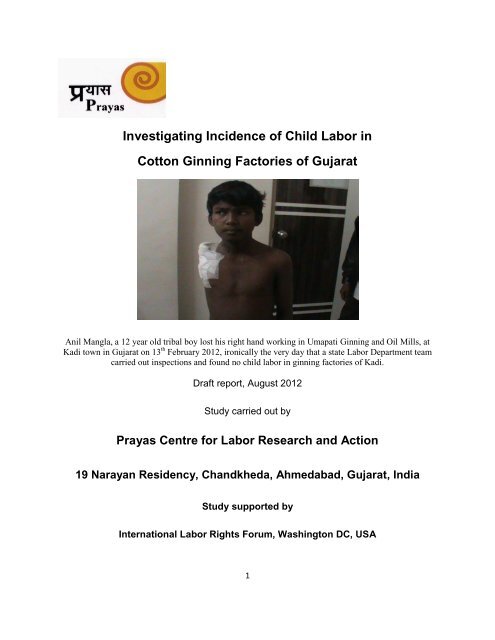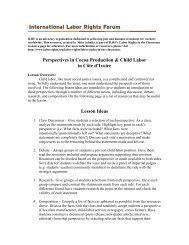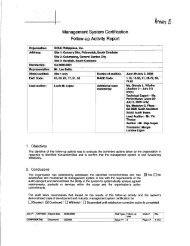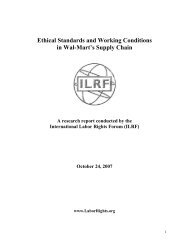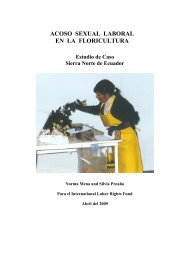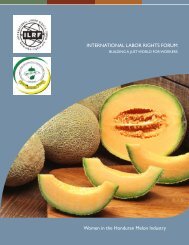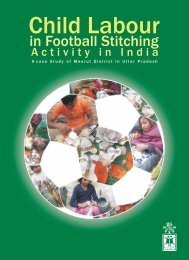Child Labor in Cotton Ginning Report.pdf - International Labor ...
Child Labor in Cotton Ginning Report.pdf - International Labor ...
Child Labor in Cotton Ginning Report.pdf - International Labor ...
You also want an ePaper? Increase the reach of your titles
YUMPU automatically turns print PDFs into web optimized ePapers that Google loves.
Investigat<strong>in</strong>g Incidence of <strong>Child</strong> <strong>Labor</strong> <strong>in</strong><br />
<strong>Cotton</strong> G<strong>in</strong>n<strong>in</strong>g Factories of Gujarat<br />
Anil Mangla, a 12 year old tribal boy lost his right hand work<strong>in</strong>g <strong>in</strong> Umapati G<strong>in</strong>n<strong>in</strong>g and Oil Mills, at<br />
Kadi town <strong>in</strong> Gujarat on 13 th February 2012, ironically the very day that a state <strong>Labor</strong> Department team<br />
carried out <strong>in</strong>spections and found no child labor <strong>in</strong> g<strong>in</strong>n<strong>in</strong>g factories of Kadi.<br />
Draft report, August 2012<br />
Study carried out by<br />
Prayas Centre for <strong>Labor</strong> Research and Action<br />
19 Narayan Residency, Chandkheda, Ahmedabad, Gujarat, India<br />
Study supported by<br />
<strong>International</strong> <strong>Labor</strong> Rights Forum, Wash<strong>in</strong>gton DC, USA<br />
1
Summary<br />
Prayas carried out the study to f<strong>in</strong>d out labor conditions <strong>in</strong> cotton g<strong>in</strong>n<strong>in</strong>g <strong>in</strong>dustry <strong>in</strong> Gujarat<br />
with a focus on employment of children and adolescents <strong>in</strong> the work season 2011-12. It was <strong>in</strong><br />
cont<strong>in</strong>uation of a similar study carried out <strong>in</strong> 2010-11 with ILRF support. The studies have<br />
generated <strong>in</strong>formation on (i) socio-economic profile of labor force (ii) <strong>in</strong>cidence of child labor<br />
(iii) wages and work<strong>in</strong>g and liv<strong>in</strong>g conditions (iv) pattern of recruitment. The study f<strong>in</strong>d<strong>in</strong>gs<br />
have provided valuable material for undertak<strong>in</strong>g advocacy work with the state and the g<strong>in</strong>n<strong>in</strong>g<br />
<strong>in</strong>dustry to improve work conditions and reduce <strong>in</strong>cidence of child labor <strong>in</strong> the <strong>in</strong>dustry.<br />
The study was undertaken <strong>in</strong> 15 cotton g<strong>in</strong>n<strong>in</strong>g factories of Kadi, Manavadar and Gondal<br />
clusters. The three districts <strong>in</strong> which these clusters are located together account for almost half<br />
the number of functional g<strong>in</strong>n<strong>in</strong>g units <strong>in</strong> the state. A total of 347 workers have been mapped. A<br />
new cluster of Manavadar <strong>in</strong> District Junagadh was added this year to broaden the scope. As<br />
expected, the survey faced difficulty <strong>in</strong> ascerta<strong>in</strong><strong>in</strong>g the child workers <strong>in</strong> the work force. The<br />
owners did their best to ensure that the survey team does not come <strong>in</strong>to contact with child and<br />
adolescent workers.<br />
The labor force <strong>in</strong> cotton g<strong>in</strong>n<strong>in</strong>g <strong>in</strong>dustry comprises of seasonal migrants and local poor<br />
communities. Though child labor was found primarily amongst the charkha workers, the team<br />
observed child labor <strong>in</strong> oil mills also. In factories where age mapp<strong>in</strong>g was possible, almost half<br />
the workforce on charkha mach<strong>in</strong>es comprises of children and adolescents below 18 years of<br />
age. The proportion of female workers is also high amongst charkha workers.<br />
Factories run seasonally from November to April- May depend<strong>in</strong>g upon stock availability. The<br />
factories operate 12 hour shifts (at times 14 hours). Two shifts are done when required. The<br />
charkha workers are not paid m<strong>in</strong>imum wages. In fact the wage rate works out to less than a third<br />
of the statutory declared m<strong>in</strong>imum wage if overtime is accounted for. In the other two major<br />
work categories, work is contracted out as opposed to charkha where only the labor recruitment<br />
is contracted out. The loader workers are paid on a per day basis by the contractor.<br />
2
The migrant workers live <strong>in</strong> accommodation provided by the factory owners with<strong>in</strong> the premises.<br />
Up to 10 workers may share rooms a 100 square feet room. The rooms are not properly<br />
ventilated. Even though there is electricity <strong>in</strong> the premises, there are no fans <strong>in</strong> the rooms. Water<br />
is normally taken from a public tap. There are no sanitation facilities.<br />
The work conditions cont<strong>in</strong>ue to be highly unsafe, especially for charkha workers who operate<br />
the mach<strong>in</strong>es. Untra<strong>in</strong>ed and very young workforce from the villages is straight away deployed<br />
<strong>in</strong> 12 hour shifts. As a result accidents are frequent. However these do not come to light. The<br />
owners do not report the accidents to the Directorate of Industrial Safety and Health as they are<br />
required to. It is only <strong>in</strong> Kadi cluster, where Prayas has been work<strong>in</strong>g for a number of years and<br />
developed good contacts amongst the work force, labor contractors, and local civil society; that<br />
an accident mapp<strong>in</strong>g was possible. There were a total of 10 accidents <strong>in</strong>clud<strong>in</strong>g two deaths. In a<br />
serious accident, a child worker lost his right hand.<br />
All the workers are recruited through labor contractors. In unload<strong>in</strong>g and press<strong>in</strong>g, work contract<br />
is given. In charkha, the contract is for supply of labor only. The contractor gets a commission on<br />
per day basis. He is also given a separate attendance. The contractors are from the same<br />
community. They source labor from the villages on the basis of k<strong>in</strong>ship networks. The<br />
contractors are responsible for br<strong>in</strong>g<strong>in</strong>g <strong>in</strong> the workers. Normally the <strong>in</strong>com<strong>in</strong>g fare is provided<br />
by the employer. There is not much evidence of significant advances be<strong>in</strong>g given to secure labor<br />
supply. This aga<strong>in</strong> shows that <strong>in</strong> the context of g<strong>in</strong>n<strong>in</strong>g, there is no shortage of labor.<br />
Prayas CLRA undertook advocacy on behalf of workers. It gave memorandum to state<br />
authorities on the issue of child labor. Media was used successfully to put pressure on the state<br />
authorities to respond <strong>in</strong> the case of serious accident of Anil Mangla. For the first time, a police<br />
report was filed aga<strong>in</strong>st the owner lead<strong>in</strong>g to his eventual arrest.<br />
The cotton g<strong>in</strong>n<strong>in</strong>g <strong>in</strong>dustry is mak<strong>in</strong>g profits by exploit<strong>in</strong>g the cheap labor of children and<br />
adolescent, and especially female adolescents whose opportunity cost of labor is zero. In Indian<br />
conditions, adolescent female girls often drop out from school and stay at home till they get<br />
3
married. It is this cheap labor forces that is mobilized by the g<strong>in</strong>n<strong>in</strong>g <strong>in</strong>dustry through its<br />
extensive network of labor contractors. Employment of children, high rate of accidents and<br />
payment of wages much below the statutory m<strong>in</strong>imum wages are major concern areas for civil<br />
society and grounds for future <strong>in</strong>tervention.<br />
4
Chapter 1<br />
Introduction<br />
<strong>Child</strong> workers <strong>in</strong> Tirupati g<strong>in</strong>n<strong>in</strong>g, near Bijapur town, January 10, 2012<br />
The problem of child labour exploitation is a major challenge to the progress of develop<strong>in</strong>g<br />
countries. <strong>Child</strong>ren work at the cost of their right to education which leaves them permanently<br />
trapped <strong>in</strong> the poverty cycle, sadly without the education and literacy required for better-pay<strong>in</strong>g<br />
jobs. This is particularly serious <strong>in</strong> India as it tops the list with the highest number of child<br />
labourers <strong>in</strong> the world. The 2001 national census of India estimated the total number of child<br />
labour, aged 5–14, to be at 17 million. Out of the 12.6 million, 0.12 million engages <strong>in</strong> hazardous<br />
job. However, accord<strong>in</strong>g to <strong>in</strong>formal labour force statistics, the problem seems to be more severe<br />
than reflected. <strong>Child</strong> labour is estimated to be as large as 60 million <strong>in</strong> India, as many children<br />
are "hidden workers" work<strong>in</strong>g <strong>in</strong> homes or <strong>in</strong> the underground economy. In the long run, this<br />
phenomenon will evolve to be both a social and an economic problem as economic disparities<br />
widen between the poor and educationally backward states and that of the faster-grow<strong>in</strong>g states.<br />
India has the highest number of labourers <strong>in</strong> the world less than 14 years of age. <strong>Child</strong> labour is<br />
5
prevalent <strong>in</strong> almost all <strong>in</strong>formal sectors of the Indian economy. Companies <strong>in</strong>clud<strong>in</strong>g Gap,<br />
Primark, Monsanto and others have been criticised for us<strong>in</strong>g child labour <strong>in</strong> either their<br />
operations <strong>in</strong> India or by their suppliers <strong>in</strong> India.<br />
Causes: Many Indian families send their children to work, with some liv<strong>in</strong>g away from home.<br />
Reasons are often associated with poverty, keep<strong>in</strong>g up with the large-size family subsistence and<br />
<strong>in</strong>adequate public education <strong>in</strong>frastructure. Families generally are also unable to afford their<br />
children’s education.<br />
“Families will have to go without their children's <strong>in</strong>come for several years, a choice many poor<br />
parents will be unable to make without help.” -BBC news<br />
Attend<strong>in</strong>g school means forgo<strong>in</strong>g a source of <strong>in</strong>come for the family. This is a common problem,<br />
especially <strong>in</strong> the low caste and m<strong>in</strong>orities of India. The demand for child labour further<br />
aggravates the situation. Many manufactur<strong>in</strong>g firms and sweatshops are strategically located at<br />
poverty-stricken areas to attract children to work as labourers.<br />
<strong>Cotton</strong> Production and G<strong>in</strong>s <strong>in</strong> Gujarat: <strong>Cotton</strong> production has registered a remarkable<br />
growth <strong>in</strong> India <strong>in</strong> recent years - from 13.6 million bales <strong>in</strong> 2002-03 to 32.9 million bales <strong>in</strong><br />
2011-12. Gujarat accounts for a major share of this production – almost one third as can be seen<br />
from the table below.<br />
Table: State wise production of cotton <strong>in</strong> India (Year 2011-12)<br />
Sl<br />
Production<br />
State<br />
(100,000 bales)<br />
1 Punjab 17.00<br />
2 Haryana 17.00<br />
3 Rajasthan 16.00<br />
4 Gujarat 114.00<br />
5 Maharashtra 69.00<br />
6 Madhya Pradesh 17.00<br />
7 Andhra Pradesh 48.00<br />
8 Karnataka 12.00<br />
9 Tamil Nadu 5.00<br />
10 Orissa 2.00<br />
6
11 Others 2.00<br />
12 Loose Supply 26.10<br />
Total 345.10<br />
Source: Central Institute for <strong>Cotton</strong> Research<br />
Gujarat is a major centre of cotton g<strong>in</strong>n<strong>in</strong>g <strong>in</strong>dustry. It not only g<strong>in</strong>s its own cotton prodced, but<br />
even receives cotton from other states, notably Maharashtra, for g<strong>in</strong>n<strong>in</strong>g. One hundred and ten<br />
new cotton g<strong>in</strong>s were established <strong>in</strong> 2007 to take advantage of the <strong>in</strong>crease <strong>in</strong> cotton cultivation<br />
area and production. There were 982 cotton g<strong>in</strong>s <strong>in</strong> Gujarat out of which 762 were functional<br />
accord<strong>in</strong>g to data provided by Directorate Industrial Safety and Health. The district wise<br />
distribution of functional g<strong>in</strong>n<strong>in</strong>g factories is given <strong>in</strong> the follow<strong>in</strong>g table. Sabarkantha,<br />
Banaskantha, Bharuch, Vadodara, Kutchh, Patan, Rajkot, Bhavanagar, Ahmedabad and<br />
Surendranagar are 10 major districts grow<strong>in</strong>g cotton. However, Kadi, a town of Mehsana district<br />
<strong>in</strong> North Gujarat, is the biggest centre for cotton g<strong>in</strong>n<strong>in</strong>g. There are 122 g<strong>in</strong>s <strong>in</strong> Kadi.<br />
Interest<strong>in</strong>gly, Mehsana is not among 10 major cotton produc<strong>in</strong>g districts <strong>in</strong> Gujarat. <strong>Cotton</strong> from<br />
neighbor<strong>in</strong>g states like Maharashtra and Madhya Pradesh is also processed <strong>in</strong> Gujarati g<strong>in</strong>s.<br />
The cotton g<strong>in</strong>n<strong>in</strong>g <strong>in</strong>dustry <strong>in</strong> Gujarat is monopolised by the Patel community which is<br />
politically, socially, and economically very powerful. This makes it very easy for the g<strong>in</strong> owners<br />
to underm<strong>in</strong>e the law and avoid government supervision and <strong>in</strong>spection without be<strong>in</strong>g caught.<br />
They rarely face legal action for violations committed <strong>in</strong> their g<strong>in</strong>s <strong>in</strong>clud<strong>in</strong>g absence of adequate<br />
safety precautions and post-<strong>in</strong>jury measures. There are no accurate estimates of number of<br />
workers <strong>in</strong> these g<strong>in</strong>s because there are official records are not accurate. Majority of the workers<br />
work<strong>in</strong>g at the g<strong>in</strong>s are casual and never put on a roster. There is no official record of attendance<br />
or nature of work allotted or payment slips and registers. However, the number of g<strong>in</strong>n<strong>in</strong>g<br />
factories <strong>in</strong> Gujarat is known. The follow<strong>in</strong>g table provides district wise distribution of cotton<br />
g<strong>in</strong>n<strong>in</strong>g factories <strong>in</strong> Gujarat. It is sourced from Directorate of Industrial Safety and Health and<br />
should be accurate as registration is mandatory. The table shows the total number of cotton<br />
g<strong>in</strong>n<strong>in</strong>g factories to be 762. Estimat<strong>in</strong>g that the smallest g<strong>in</strong> consist of 10-12 charkhas and<br />
employs 50-60 workers while bigger units employ 36-40 charkhas and 125-130 workers,<br />
7
consider<strong>in</strong>g that 70 percent are small units and 30 percent big units, the estimated number of<br />
workers would come to a total of approximately 55,000, which is a large workforce.<br />
Table: List of cotton g<strong>in</strong>n<strong>in</strong>g factories <strong>in</strong> Gujarat<br />
Sl District No. of open mills<br />
1 Ahmedabad 77<br />
2 Patan 27<br />
3 Mehsana 137<br />
4 Vadodara 40<br />
5 Sabarkantha 33<br />
6 Amreli 28<br />
7 Bhavnagar 47<br />
8 Junagadh 92<br />
9 Rajkot 144<br />
10 Bharuch 24<br />
11 Surendranagar 72<br />
12 Other districts 41<br />
762<br />
Source: Directorate of Industrial Safety and Health<br />
Legal Provisions for <strong>Cotton</strong> G<strong>in</strong>s<br />
<strong>Cotton</strong> g<strong>in</strong>n<strong>in</strong>g is a seasonal <strong>in</strong>dustry because cotton is not available throughout the year.<br />
However, some g<strong>in</strong>s also undertake extraction of cotton seed oil which is not a seasonal<br />
bus<strong>in</strong>ess. Oil extract<strong>in</strong>g factories are excluded from seasonal status and are, therefore, covered by<br />
the Employment Social Insurance Scheme Act (ESIS Act), while the cotton g<strong>in</strong>s are only<br />
covered by the Factories Act.<br />
The Factories Act provides for the basic rights for health and safety to protect workers. Important<br />
provisions are limits on work<strong>in</strong>g hours ( 9 hours a day and 48 hours per week), limits on<br />
overtime work (50 hours <strong>in</strong> a quarter) the provision for double the wages for overtime work,<br />
weekly rest allocation, worker identity cards, attendance cards, leave cards, leave with wages,<br />
regulation for tight fitt<strong>in</strong>g clothes, mach<strong>in</strong>e guard<strong>in</strong>g etc. Unfortunately, all these provisions are<br />
blatantly violated.<br />
The M<strong>in</strong>imum Wages Act is also applicable to cotton g<strong>in</strong>s but the general observation has been<br />
that workers are not paid m<strong>in</strong>imum wages. The Interstate Migrant Workers (Protection and<br />
8
Regulation) Act and the Contract Labour (Abolition and Regulation) Act are also designed to<br />
protect workers <strong>in</strong>clud<strong>in</strong>g the g<strong>in</strong> workers. Further, the Workmen’s Compensation Act of 1923<br />
applies to <strong>in</strong>jured g<strong>in</strong> workers. Unfortunately, none of these labour laws are implemented well<br />
and, as a result, the workers, who are largely unorganized, are exploited <strong>in</strong> all manners.<br />
<strong>Child</strong> <strong>Labor</strong> (Regulation and Prevention) Act governs employment of children <strong>in</strong> India. <strong>Child</strong>ren<br />
are classified as below 14 years of age. The Act regulates employment of children <strong>in</strong> certa<strong>in</strong><br />
occupations and prohibits <strong>in</strong> other occupations. Thus there is a list of prohibited occupations.<br />
<strong>Cotton</strong> g<strong>in</strong>n<strong>in</strong>g <strong>in</strong>dustry falls <strong>in</strong> the list of prohibited occupations. The Act has been widely<br />
criticized by civil society on many grounds. The chief are a low age def<strong>in</strong><strong>in</strong>g children (just 14<br />
years) and allow<strong>in</strong>g employment of children <strong>in</strong> certa<strong>in</strong> occupations (as opposed to a blanket ban).<br />
There are other legislations that are considered more progressive and often used to check child<br />
labor. The chief amongst these are Juvenile Justice Act and Right to Education Act. The JJ Act<br />
def<strong>in</strong>es age of adolescent up to 18 years. While there is no specific law <strong>in</strong> India aga<strong>in</strong>st<br />
traffick<strong>in</strong>g for wage labor, JJ Act can be used <strong>in</strong> such situations. The Right to Education Act<br />
makes it mandatory for the state to ensure that all children below 14 years are enrolled <strong>in</strong> a<br />
school.<br />
It has been observed that no union has significantly taken up the legal issues of these exploited<br />
g<strong>in</strong> workers until the <strong>Cotton</strong> G<strong>in</strong>n<strong>in</strong>g and Other Mill Workers Union was created <strong>in</strong> 2006. The<br />
Union pursued several legal cases <strong>in</strong> regard to all of the above mentioned Acts on behalf of the<br />
workers.<br />
Organisation of the workplace<br />
<strong>Cotton</strong> g<strong>in</strong>n<strong>in</strong>g is a seasonally run <strong>in</strong>dustry-- from November to April. Dur<strong>in</strong>g the g<strong>in</strong>n<strong>in</strong>g season<br />
all factories run 24 hours <strong>in</strong> 2 shifts of 12 hours each—the day and night. There is no weekly day<br />
off. G<strong>in</strong>n<strong>in</strong>g is done by the mechanized raw cotton feeder mach<strong>in</strong>e or ‘mach<strong>in</strong>e charkha’—as it<br />
is called locally. About 3-4 years back, raw cotton was fed manually where<strong>in</strong> one worker<br />
manned one feeder, while <strong>in</strong> the mechanized feeder one person manages <strong>in</strong>put by hand, without<br />
any contraption, <strong>in</strong>to 4 charkhas at a time. Similarly, at the output po<strong>in</strong>t, there is one person who<br />
manages 4 charkhas, with the help of a broom or a plank. At the output site near the expeller<br />
9
cotton that spills over, has to be pushed back <strong>in</strong>to the conveyor belt channel (‘gallery’), towards<br />
the blower; and one person for 4 charkhas also manages this operation. Besides, several<br />
labourers are employed at the bale mak<strong>in</strong>g mach<strong>in</strong>es, and then for stack<strong>in</strong>g and load<strong>in</strong>g cotton<br />
bales onto trucks, and yet others for pill<strong>in</strong>g up tractor trolleys with the by-product cottonseed.<br />
Further, supervisors, fitters and ma<strong>in</strong>tenance people are around. The largest number of laborers<br />
works at the mechanized charkhas and the narrow conveyor belt gallery. These are also the sites<br />
of most <strong>in</strong>juries, as <strong>in</strong> none of these tasks are any safety norms observed or protective gadgets<br />
used.<br />
10
Chapter 2<br />
Study Objectives and Methodology<br />
<strong>Child</strong> workers at Tirupati cotton g<strong>in</strong>n<strong>in</strong>g factory <strong>in</strong> North Gujarat 10 th January 2012<br />
Study objectives<br />
The study sought to study labor conditions <strong>in</strong> cotton g<strong>in</strong>n<strong>in</strong>g <strong>in</strong>dustry <strong>in</strong> Gujarat with a focus on<br />
employment of children and adolescents. The study was expected to generate <strong>in</strong>formation on<br />
<br />
Socio-economic profile of labor force <strong>in</strong> cotton g<strong>in</strong>n<strong>in</strong>g factories - Migrant/ local, male/<br />
female, educational levels, sociological profile (SC/ ST/ other backward castes),<br />
economic background – land and other asset hold<strong>in</strong>g<br />
<br />
<br />
<br />
Incidence of child labor<br />
Wages and Work<strong>in</strong>g and liv<strong>in</strong>g conditions – hours of work, terms of employment, wage<br />
levels, payment of wages, and <strong>in</strong>cidence of accidents<br />
Pattern of recruitment: How are workers recruited Existence of labor contractors, their<br />
social profile, advances offered if any<br />
<br />
Advocacy work on behalf of workers: Prayas CLRA is already engaged <strong>in</strong> mobilis<strong>in</strong>g and<br />
organiz<strong>in</strong>g workers through Mazdoor Adhikar Manch. The study f<strong>in</strong>d<strong>in</strong>gs will help <strong>in</strong> the<br />
Union to spread to new areas and launch a campaign on behalf of workers.<br />
Type and methodology of research<br />
The study has been carried out <strong>in</strong> three clusters of Gujarat – Kadi <strong>in</strong> District Mahesana,<br />
Manavadar <strong>in</strong> Junagadh District and Gondal <strong>in</strong> District Rajkot. All these are major clusters. In<br />
fact Kadi is widely recognized to be the centre of cotton g<strong>in</strong>n<strong>in</strong>g <strong>in</strong>dustry with more than a 100<br />
11
cotton g<strong>in</strong>n<strong>in</strong>g factories. Of late, a movement has been reported from Kadi to Gondal. Kadi is<br />
located near Ahmedabad and is a major <strong>in</strong>dustrial area. G<strong>in</strong>n<strong>in</strong>g factories require a large amount<br />
of land where cotton can be kept. As real estate prices move up, the Kadi owners f<strong>in</strong>d it<br />
profitable to sell off the factory land and set up the factory <strong>in</strong> new locations where land is<br />
cheaper.<br />
Sample: A sample of 15 cotton g<strong>in</strong>n<strong>in</strong>g factories was taken up for survey. The list of factories<br />
where study has been carried out is given <strong>in</strong> Annexure 1 (a). A total of 348 workers were<br />
mapped that is their names listed. The schedules used for factory mapp<strong>in</strong>g and wage labor<br />
mapp<strong>in</strong>g are given <strong>in</strong> Annexure 1 (b).<br />
<strong>Child</strong> labor is found primarily amongst the charkha workers. It was very difficult to trace<br />
<strong>in</strong>cidence of child labor. The workers live with<strong>in</strong> closed boundaries where access is strictly<br />
regulated by watchmen. Even the outside of the factory gate is regularly kept under watch.<br />
Presence of outsiders is immediately taken note of. Last few years have seen lot of public noise<br />
on issue of child labor. As a result all stakeholders <strong>in</strong> the process – employers, labor contractors,<br />
and the parents of the child workers – do not acknowledge the presence of children amongst<br />
work force. There is a sense of illegality attached and so nobody wants to accept it.<br />
Two different approaches were followed <strong>in</strong> the three clusters picked up for survey work. In Kadi,<br />
Prayas has been undertak<strong>in</strong>g mobilization work with the workers for last four years. It had<br />
familiarity with the workers and labor contractors. The employers also knew Prayas very well.<br />
The employers have actively opposed presence of Prayas <strong>in</strong> the area and even went to the extent<br />
of resort<strong>in</strong>g to physical violence. In view of this situation, it was decided to undertake wage labor<br />
mapp<strong>in</strong>g directly with the workers and labor contractors without br<strong>in</strong>g<strong>in</strong>g <strong>in</strong> the employers <strong>in</strong>to<br />
the loop. For labor mapp<strong>in</strong>g, help of the labor contractor was taken <strong>in</strong> Kadi. Prayas has<br />
undertaken mobilization work amongst labor contractors and has some contact. For unload<strong>in</strong>g<br />
and bale mak<strong>in</strong>g (press work), there were no problems and contractors were ready to share<br />
<strong>in</strong>formation on workers <strong>in</strong>clud<strong>in</strong>g their age. However the charkha contractors were not will<strong>in</strong>g to<br />
reveal the exact age of workers. They would <strong>in</strong>variably give the age of all child and adolescent<br />
workers as 18. It was decided to undertake direct verification of age of workers. This <strong>in</strong>volved<br />
go<strong>in</strong>g <strong>in</strong>side the campus surreptitiously and meet<strong>in</strong>g the workers. The second option used was to<br />
<strong>in</strong>terview a worker and ask her/ him the age of his/ her colleagues. This was not possible at all<br />
the g<strong>in</strong>s selected for mapp<strong>in</strong>g.<br />
In contrast, Gondal and Manavadar, Prayas did not have many contacts amongst the workers as<br />
these are new areas for Prayas <strong>in</strong>tervention. Here it was decided to use local activists to<br />
undertake the wage labor mapp<strong>in</strong>g. This was also thought prudent from a longer term strategic<br />
perspective. It is hoped that the local activists, while do<strong>in</strong>g the survey, will be sensitized to the<br />
problems of workers most of whom are migrants with no local support. The more active amongst<br />
them may even feel motivated to undertake direct mobilization work amongst g<strong>in</strong>n<strong>in</strong>g workers. It<br />
was thought that it would not be possible to forge direct contact with the workers with<strong>in</strong> the short<br />
12
span of time available for the study. So it was decided to go through the employers. The survey<br />
team established direct contact with the employers and told them that they want to undertake a<br />
survey of workers with a view to deliver welfare activities like medical camp. One of the<br />
employers permitted them after some persuasion. However they made it very clear that there<br />
should be no attempt to establish presence of children amongst workers. General mapp<strong>in</strong>g was<br />
done openly with<strong>in</strong> factory premises <strong>in</strong> presence of supervisory staff. The age verification of<br />
child labor was done <strong>in</strong> secret here also often dur<strong>in</strong>g the night when employers were not present.<br />
In Gondal child labor has been reported amongst the local workers also. The age verification of<br />
local workers was done <strong>in</strong> their villages.<br />
The Gondal team faced many problems <strong>in</strong> establish<strong>in</strong>g presence of child workers. These are<br />
listed below<br />
<br />
<br />
<br />
<br />
Factory owner would give only those names that are <strong>in</strong> their records. This number is<br />
always a small proportion of the total workforce – most of which is not enrolled <strong>in</strong> any<br />
official data base. They would typically ask the <strong>in</strong>vestigators to stay put <strong>in</strong> office and not<br />
go beyond. The workers would be brought there only for record<strong>in</strong>g.<br />
The factory owners were very afraid of child labor be<strong>in</strong>g found amongst the workers. So<br />
while they allowed the load<strong>in</strong>g and press<strong>in</strong>g workers to be listed as these are mostly male<br />
and adults. The children, adolescent, and female workers are mostly found amongst<br />
charkha workers. They therefore did not allow access to charkha workers who would<br />
mostly be work<strong>in</strong>g <strong>in</strong>side factory premises.<br />
They were very <strong>in</strong>sistent that none of the children are to be recorded. Any attempt would<br />
immediately be censored. In one case <strong>in</strong> Jalaram factory, when the <strong>in</strong>vestigator took<br />
photographs on the mobile of local girls com<strong>in</strong>g <strong>in</strong> to work, it led to a scuffle. The<br />
<strong>in</strong>vestigator was forced to delete the photos from the mobile.<br />
The workers were also not very cooperative. There was no prior contact with workers.<br />
They were reluctant to put down their name on any piece of paper. They would assume<br />
that it was be<strong>in</strong>g done for security reasons. The employers and labor contractors had<br />
created the impression that if any children are discovered, they would be thrown out of<br />
the factory and may be even imprisoned.<br />
The team of <strong>in</strong>vestigators tried their best to overcome these constra<strong>in</strong>ts. The methods they used<br />
were<br />
<br />
Seem<strong>in</strong>gly un<strong>in</strong>tentional walk through the factory: The <strong>in</strong>vestigators made a number of<br />
visits. Each factory was visited at least five six times. There would be an <strong>in</strong>itial visit<br />
followed by a visit to record workers. Then there were visits to set up the medical camps.<br />
Towards the end the owner and the supervisory staff had become a bit familiar with the<br />
team. So towards the end, one member of the survey team would slip out unannounced<br />
and walk through the factory observ<strong>in</strong>g th<strong>in</strong>gs first hand. This methodology paid good<br />
13
dividends as some children were observed work<strong>in</strong>g. Some footage has also been<br />
obta<strong>in</strong>ed.<br />
<br />
Visit<strong>in</strong>g residence of local workers: Where local workers were reported go<strong>in</strong>g for charkha<br />
work, the team visited their villages. However even here it was not possible to record<br />
work<strong>in</strong>g children. The workers were aware that child labor is illegal. So no young<br />
workers showed up at these village meet<strong>in</strong>gs.<br />
<br />
Befriend<strong>in</strong>g labor contractors: The survey team tried to befriend the labor contractors. A<br />
separate meet<strong>in</strong>g of contractors was also organized.<br />
Limitations<br />
1. The study has been carried out <strong>in</strong> three ma<strong>in</strong> clusters <strong>in</strong> Gujarat. However as shown <strong>in</strong> the<br />
Table (1), there are many more clusters <strong>in</strong> Saurashtra. Not much is known about the labor<br />
composition <strong>in</strong> these clusters. The results of this study may not hold for these clusters.<br />
2. The age of the children will rema<strong>in</strong> a matter of dispute. The field <strong>in</strong>vestigators have listed<br />
the age on the basis of direct observation. But it is very difficult to prove the exact age of<br />
child.<br />
14
Chapter 3<br />
Study F<strong>in</strong>d<strong>in</strong>gs<br />
<strong>Child</strong> workers at Raghuveer G<strong>in</strong>n<strong>in</strong>g Rajkot Gondal Highway, 1 st March 2012<br />
Socio-economic profile of labor force: <strong>in</strong> cotton g<strong>in</strong>n<strong>in</strong>g factories - Migrant/ local, male/<br />
female, educational levels, sociological profile (SC/ ST/ other backward castes), economic<br />
background – land and other asset hold<strong>in</strong>g<br />
There are five ma<strong>in</strong> categories of labor force <strong>in</strong> cotton g<strong>in</strong>n<strong>in</strong>g factories<br />
<br />
<br />
Unload<strong>in</strong>g<br />
Charkha<br />
<br />
<br />
<br />
Fitters<br />
Bale mak<strong>in</strong>g/ press<strong>in</strong>g<br />
Supervisory staff<br />
Each work is performed by a separate ethnic group.<br />
Unload<strong>in</strong>g: The raw cotton comes <strong>in</strong> trucks from cotton produc<strong>in</strong>g areas. The trucks have to be<br />
unloaded <strong>in</strong> the shade from where cotton is picked up through mechanical conveyors and<br />
transported to the ma<strong>in</strong> factory. There is a committed workforce for the task of unload<strong>in</strong>g. These<br />
workers are from the state of Bihar, a North Indian state some 2000 kms away. With<strong>in</strong> Bihar<br />
15
they are from the districts of Phulbani <strong>in</strong> an area called Mithila. Nearly all these workers are<br />
from the Scheduled Castes 1 like Kevat and Paswan. There are no female workers <strong>in</strong> this group<br />
that comprises primarily of adult males. However at some places children were observed <strong>in</strong> this<br />
group also.<br />
Charkha: This is the ma<strong>in</strong> factory part of the operation. These workers work on the raw cotton<br />
feeder at both ends. These workers can be (i) local from the surround<strong>in</strong>g villages (ii) migrants<br />
from tribal South Rajasthan and Western MP. This is the area where children get employed.<br />
Most of the workforce comprises of children and adolescents. Even from with<strong>in</strong> local population,<br />
primarily adolescents do this work. Sometimes older persons who are unable to f<strong>in</strong>d employment<br />
elsewhere also work. There is high proportion of female workers <strong>in</strong> this segment. Each worker<br />
handles three or four charkhas. South Rajasthan is a predom<strong>in</strong>antly tribal area. Tribal areas <strong>in</strong><br />
India are the poorest with<strong>in</strong> the country. The local Gujarati workers come from ma<strong>in</strong>ly<br />
Scheduled Caste communities like vankar and chamar. While these areas are highly<br />
<strong>in</strong>dustrialized, the Scheduled Caste communities are the poorest. They have very little land<br />
hold<strong>in</strong>g. Wage rates rema<strong>in</strong> low despite heavy <strong>in</strong>dustrialization because of <strong>in</strong>flux of a huge<br />
amount of migrant labor from outside.<br />
Fitters: The factory segment also has a significant number of fitters. This is the technically<br />
qualified staff that monitors production and is responsible for smooth function<strong>in</strong>g of the<br />
mach<strong>in</strong>es. These workers have some education. Some are technically qualified while others have<br />
picked up the skill through experience. Most of these workers are from the North Indian state of<br />
Uttar Pradesh. This is aga<strong>in</strong> an all male workforce.<br />
Bale mak<strong>in</strong>g: After the cotton has been g<strong>in</strong>ned, it is pressed <strong>in</strong>to bales. The bales are then taken<br />
out of the factory shed <strong>in</strong>to open compound where these are loaded <strong>in</strong>to trucks for onward<br />
transport. This work is primarily carried out by workers from Marwar area <strong>in</strong> Western Rajasthan.<br />
There are no female workers <strong>in</strong> this segment. It is all adult males. The workers belong to bisnoi<br />
caste, an upper caste with significant land hold<strong>in</strong>g.<br />
Supervisors: This is the supervisory staff that supervises overall operations. Mostly local<br />
workers are hired for this job.<br />
This clear cut division of labor along ethnic l<strong>in</strong>es is replicated <strong>in</strong> Gondal as well. There are m<strong>in</strong>or<br />
changes. Gondal also receives workers from Bihar and Rajasthan. The movement of labor across<br />
the country is shown <strong>in</strong> the map of India. However there is a dist<strong>in</strong>ct change <strong>in</strong> Manavadar<br />
cluster, where nearly all workers are local. It needs to be noted that Manavadar is located furthest<br />
away from the state capital Ahmedabad <strong>in</strong> Saurashtra.<br />
1 Scheduled Castes are the castes at the bottom of the Indian caste system. These castes used to be considered<br />
untouchable and performed menial tasks like clean<strong>in</strong>g and scaveng<strong>in</strong>g.<br />
16
Table 2: Socio economic profile of labor force <strong>in</strong> different clusters<br />
Cluster/ Type Charkha Unload<strong>in</strong>g Press<strong>in</strong>g Fitter<br />
of work<br />
Kadi South Rajasthan/<br />
tribal<br />
Bihar/ SC<br />
West Rajsthan/ Upper<br />
caste, SC<br />
UP/ upper<br />
caste<br />
Manavadar Local/ dalit Local/dalit Local/dalit Local/dalit<br />
Gondal North Gujarat. local/<br />
tribal, SC<br />
West Rajasthan/<br />
Upper caste, SC<br />
West Rajasthan/ Upper<br />
caste, SC<br />
Maharashtra/<br />
SC<br />
17
The map on the follow<strong>in</strong>g page shows the movement of workers from different parts of the<br />
country to cotton g<strong>in</strong>n<strong>in</strong>g areas <strong>in</strong> Gujarat. The different colors <strong>in</strong>dicate different work types.<br />
Figure 1: Inter-state movement of g<strong>in</strong>n<strong>in</strong>g workers<br />
18
The ethnic clusters are described below<br />
<br />
<br />
<br />
Local dalits: The local dalit communities provide labor for charkha work <strong>in</strong> cotton<br />
g<strong>in</strong>n<strong>in</strong>g factories. Dalits are at the bottom of social economic ladder <strong>in</strong> pla<strong>in</strong>s of Gujarat.<br />
They are either landless or marg<strong>in</strong>al farmers. G<strong>in</strong>n<strong>in</strong>g provides employment for ether the<br />
young or the very old who cannot f<strong>in</strong>d employment elsewhere. In Manavadar cluster, all<br />
work is undertaken by local dalit communities. There are no migrant workers.<br />
Tribals from South Rajasthan and Western MP: Tribal labor is recruited to work <strong>in</strong><br />
charkha mach<strong>in</strong>es. Tribal communities have traditionally rema<strong>in</strong>ed outside the caste<br />
system. They <strong>in</strong>habit hilly tracts where agriculture land is limited. Tribal communities<br />
form the poorest section of Indian society.<br />
Dalits from Mithilanchal <strong>in</strong> Bihar: The unloaders all come from the dalit community of<br />
Mithila area <strong>in</strong> Bihar state. They are a highly oppressed group back home. Most of them<br />
are landless.<br />
<br />
<br />
Marwari labor: There is some mix<strong>in</strong>g of caste groups <strong>in</strong> this category. While the majority<br />
of labor comes from upper caste Bishnoi, there are dalits also present. It seems that the<br />
contractors are mostly upper caste while labor is mixed. Most workers will have some<br />
agriculture land. The Bishnoi community is a dom<strong>in</strong>ant landholder<br />
UP: The fitters <strong>in</strong> Kadi cluster all come from UP. They are mostly upper caste. In<br />
Manavadar cluster, fitters are from Maharashtra.<br />
Gender profile: Female workers are employed only <strong>in</strong> charkha work. In rest of the work<br />
categories, it is males only who are employed. Amongst charkha workers, female workers are<br />
preferred and outnumber male workers as shown <strong>in</strong> figure below.<br />
Figure 2<br />
Source: PCLRA survey<br />
19
Educational status of workers: Most of the workers come from deprived communities at the<br />
bottom of the socio-economic ladder <strong>in</strong> India – the dalits and the scheduled tribes. Amongst<br />
charkha workers, there is a significant proportion of child workers – children who have dropped<br />
out from school to start work<strong>in</strong>g <strong>in</strong> g<strong>in</strong>s. More than one third of the total work force is illiterate.<br />
A little less than one half – 48 percent – have studied above primary level.<br />
Figure 3<br />
0%<br />
EDUCATION<br />
ABOVE<br />
PRIMARY, 48.2%<br />
ILLITERATE, 35.5%<br />
ILLITERATE<br />
PRIMARY<br />
ABOVE PRIMARY<br />
PRIMARY,16.2%<br />
Source: PCLRA survey<br />
20
Incidence of child labor<br />
Incidence of child labor is calculated only for the charkha workers <strong>in</strong> Kadi g<strong>in</strong>n<strong>in</strong>g factories as it<br />
was not possible to ascerta<strong>in</strong> age of workers <strong>in</strong> factories elsewhere for reasons specified earlier.<br />
The number of children below 14 years of age, the def<strong>in</strong><strong>in</strong>g age for children under India’s <strong>Child</strong><br />
<strong>Labor</strong> Act, is 8 percent. However if we take children to be below 18 years of age as specified<br />
under <strong>in</strong>ternational conventions and also under India’ Juvenile Justice Act, the number of child<br />
workers goes up to the half way mark at 48 percent.<br />
Figure 4<br />
Source: PCLRA survey<br />
Wages, Work<strong>in</strong>g & Liv<strong>in</strong>g Conditions<br />
Wage levels: Amongst the different categories of workers, only charkha workers are employed<br />
directly by the employers. In other categories, factory owners give work contract to contractors<br />
who get paid on a piece rate basis. The contractors <strong>in</strong> turn arrange the work crew and pay them.<br />
The workers may be paid on a piece rate basis or also on a per day basis.<br />
Charkha workers: The wages <strong>in</strong> Kadi and Gondal for charkha workers are Rs. 120 to Rs. 140<br />
per day for a 12 hour shift. This is much below the m<strong>in</strong>imum wage level. The Government<br />
notification mandates a m<strong>in</strong>imum wage of Rs. 180 for an eight hour day. As workers do a 12<br />
hour shift, the m<strong>in</strong>imum wage <strong>in</strong>clud<strong>in</strong>g overtime should be Rs. 360 per day. Thus the workers<br />
are gett<strong>in</strong>g less than half the m<strong>in</strong>imum wages.<br />
21
Unload<strong>in</strong>g: The unload<strong>in</strong>g workers are paid on a piece rate. They get Rs. 300 for unload<strong>in</strong>g a<br />
truck by the factory owner. The trucker pays another Rs. 200. Normally a crew of 8 workers<br />
works together.<br />
Press<strong>in</strong>g: The press<strong>in</strong>g work is contracted out to a contractor who arranges the workers. The<br />
contractor gets paid Rs. 14 for mak<strong>in</strong>g a bale of cotton, number<strong>in</strong>g it and tak<strong>in</strong>g to the truck to be<br />
loaded. For load<strong>in</strong>g, the truck owner pays Rs. 2000. A large truck will take 150 bales. The<br />
press<strong>in</strong>g workers also carry out the job of pack<strong>in</strong>g oil cake <strong>in</strong>to sacks of 50 kg. The piece rate for<br />
this is Rs. 2 per bag. The workers normally work on 24 hour shifts. They are paid Rs. 100 for a<br />
12 hour shift and Rs. 200 for a 24 hour shift.<br />
Hours of work: A 12 hour shift is the norm <strong>in</strong> cotton g<strong>in</strong>n<strong>in</strong>g factories at both the locations.<br />
There is one day shift from 8PM to 8AM and one night shift from 8 AM to 8 PM.<br />
Payment of wages: Payment of wages is done regularly. It takes place either monthly or<br />
fortnightly. There were few compla<strong>in</strong>ts received on this count. However <strong>in</strong> case of children, the<br />
wages are kept with the labor contractor who settles accounts at the end of the season. He can<br />
siphon off. In Gondal, it was reported that while factory owners provide to and fro fare, the labor<br />
contractor pays only for the onward journey. The workers pay for the return journey.<br />
Liv<strong>in</strong>g conditions: The <strong>in</strong>ter-state migrant workers live <strong>in</strong> accommodation provided by the<br />
employers. This is very basis. There are 10x10 rooms provided for groups of workers. Workers<br />
from the same village/ same extended family stay together. Dr<strong>in</strong>k<strong>in</strong>g water is available from a<br />
public tap and has to be fetched. There is general squalor all around as can be seen <strong>in</strong> the video<br />
footage taken. There are no sanitation facilities and workers have to use open spaces to relieve<br />
themselves.<br />
Social security: There exists a number of legislation to protect workers and ensure their social<br />
security. These are the Provident Fund Act, Pension Act, Gratuity Act, ESI Act. None of these<br />
acts are followed at all <strong>in</strong> g<strong>in</strong>n<strong>in</strong>g <strong>in</strong>dustry. The workers are not shown on permanent rolls of the<br />
company.<br />
Occupational Health and Safety<br />
Occupational health: <strong>Cotton</strong> g<strong>in</strong>n<strong>in</strong>g factories provide a risky work environment with cotton<br />
particles float<strong>in</strong>g around and gett<strong>in</strong>g <strong>in</strong>to respiratory tract. The workers are not provided with any<br />
protective gear. Susta<strong>in</strong>ed exposure to cotton particles leads to a disease called byss<strong>in</strong>osis.<br />
However the prevalence of this disease is prevented by the high turnover of workers. Most<br />
charkha workers work <strong>in</strong> <strong>in</strong>dustry for only the short duration of their adolescence. Thus typically<br />
the girls will work only till their marriage. Common diseases that the workers are exposed to <strong>in</strong><br />
the typical work environment of cotton g<strong>in</strong>n<strong>in</strong>g are<br />
22
Respiratory trouble: Normally the first exposure to g<strong>in</strong>n<strong>in</strong>g factory leads to problems <strong>in</strong><br />
respiration. This goes away after medication as the workers get used to the presence of<br />
cotton.<br />
Sk<strong>in</strong> problem: Exposure to cotton on naked limbs can produce itch<strong>in</strong>g and sk<strong>in</strong> problems.<br />
Muscle pa<strong>in</strong>: The workers have to work <strong>in</strong> 12 hour shifts. They manage 3 to 4 charkhas.<br />
This requires constant stand<strong>in</strong>g lead<strong>in</strong>g to pa<strong>in</strong> <strong>in</strong> legs.<br />
Accidents and <strong>in</strong>juries: Accidents are very common <strong>in</strong> cotton g<strong>in</strong>n<strong>in</strong>g factories. PCLRA<br />
prepared a list of 105 serious accident cases <strong>in</strong> the year 2009 and held a public hear<strong>in</strong>g.<br />
Accidents cont<strong>in</strong>ue to take place.<br />
The survey has been able to generate <strong>in</strong>formation on accidents <strong>in</strong> Kadi factories. However <strong>in</strong><br />
Gondal and Manavadar, neither the workers nor the employers were ready to share this data. As<br />
can be seen, serious accidents cont<strong>in</strong>ue to occur <strong>in</strong> Kadi on a regular basis.<br />
List of Accidents <strong>in</strong> <strong>Cotton</strong> G<strong>in</strong>n<strong>in</strong>g Factories of Kadi <strong>in</strong> 2011-12 season<br />
Sl Name of<br />
woker<br />
1 Ajit Ramji<br />
Aegat<br />
Address Factory Factory Address Date of<br />
accident<br />
Paadliya, Amivarsha Nani Kadi, Vidaj<br />
Udaipur<br />
Road near canal<br />
Age &<br />
Sex<br />
Male<br />
Description<br />
Got hurt on<br />
Cheek<br />
2 Sangita<br />
Damor<br />
Mahudia,<br />
Udaipur<br />
Shulabh<br />
cotton<br />
Ankekh, Kadi,<br />
Chatral Highway<br />
Female<br />
Got hurt on<br />
stomach<br />
3 Pankaj<br />
Apsa<br />
Bhagora<br />
Bhimani<br />
G<strong>in</strong>n<strong>in</strong>g<br />
Daitroj, Kadi<br />
Early<br />
January<br />
25<br />
years,<br />
Male<br />
Leg <strong>in</strong><br />
conveyor<br />
4 Hira Lal Pipalbara,<br />
Udaipur<br />
Kot<br />
g<strong>in</strong>n<strong>in</strong>g<br />
Detroj Road, Kadi<br />
19 th<br />
February<br />
2012<br />
25<br />
years,<br />
Male<br />
Got hurt on<br />
left leg<br />
5 Anil<br />
Mangla<br />
Paadliya,<br />
Udaipur<br />
Umapati<br />
G<strong>in</strong>n<strong>in</strong>g<br />
Detroj Road, Kadi<br />
13 th<br />
February<br />
2012<br />
Male<br />
Right hand<br />
totally cut<br />
6 Harish<br />
Ahaari<br />
Nenbara,<br />
Udaipur<br />
Pragati<br />
g<strong>in</strong>n<strong>in</strong>g<br />
Rangporda, Kadi<br />
19 th<br />
October<br />
2011<br />
12 year,<br />
Male<br />
Got hurt on<br />
f<strong>in</strong>ger of left<br />
feet<br />
7 Shailesh<br />
Asari<br />
16<br />
years,<br />
Male<br />
23
8 Vidya<br />
Chauhan<br />
Barothi,<br />
Udaipur<br />
Ekta<br />
g<strong>in</strong>n<strong>in</strong>g<br />
Nani Kadi, Gujrat<br />
October<br />
2010<br />
Female<br />
Got hurt on<br />
left leg<br />
9 Bihari<br />
worker<br />
Raja<br />
G<strong>in</strong>n<strong>in</strong>g<br />
Kadi January Male Death due to<br />
asphyxiation<br />
10 Local dalit Sahkari<br />
G<strong>in</strong>n<strong>in</strong>g<br />
Village Rampura,<br />
Da<strong>in</strong>troj,<br />
January Female Death, 3 lakh<br />
Source: Field team of Majdoor Adhikar Manch<br />
Three case studies are given <strong>in</strong> detail <strong>in</strong> Annexure 2.<br />
Pattern of Recruitment<br />
All workers, whether local or <strong>in</strong>ter-state migrants, are recruited through contractors. Terms differ<br />
accord<strong>in</strong>g to work type. In charkha work, contract is for supply of labor only. In other work,<br />
unload<strong>in</strong>g, press<strong>in</strong>g, and mach<strong>in</strong>e ma<strong>in</strong>tenance (fitter), work contract is given. The contractor<br />
gets a piece rate and then hires workers. The list of labor contractors is given <strong>in</strong> Annexure 3.<br />
Social profile of contractors: Contractors are normally from the same community as the<br />
workers. Mostly they are ex workers. Most contractors will take contracts for one or two<br />
factories. However for some of the larger contractors, this number may go up to five. There are<br />
no very large contractors. The list of contractors is attached <strong>in</strong> Annexure.<br />
Advance: While some advance is given, it is not a very large amount. However even though<br />
advance is not large, various factors make it difficult for workers to leave once they have come<br />
and started work<strong>in</strong>g. The employers are not will<strong>in</strong>g to let go a settled workers as this may have a<br />
direct bear<strong>in</strong>g on production.<br />
Charkha workers have a short work<strong>in</strong>g life. It is mostly the adolescent and very young who<br />
work. Once they grow up, they stop work<strong>in</strong>g. Primary reason is the low wages <strong>in</strong> the <strong>in</strong>dustry.<br />
The wages are too low to susta<strong>in</strong> adult workers. For example, mostly adult workers prefer to<br />
work <strong>in</strong> construction <strong>in</strong>dustry where they can earn up to Rs. 250 dur<strong>in</strong>g an eight hour work day<br />
as aga<strong>in</strong>st Rs. 120 <strong>in</strong> cotton g<strong>in</strong>n<strong>in</strong>g factories for a 12 hour shift. The charkha workers of Kadi<br />
were asked as to how much time they have spent <strong>in</strong> cotton g<strong>in</strong>n<strong>in</strong>g <strong>in</strong>dustry. As can be seen, only<br />
a quarter of workers have spent more than five years <strong>in</strong> the <strong>in</strong>dustry.<br />
Chart 5<br />
24
NUMBER OF YEARS IN GINNING<br />
MORE THAN 5<br />
YEARS, 25%<br />
UPTO 1<br />
YEAR, 20.60%<br />
2 YEARS, 14.50%<br />
5 YEARS, 18.40%<br />
4 YEARS, 11.80%<br />
3 YEARS, 9.60%<br />
Source: PCLRA survey<br />
High turnover: There is a high turnover. Workers will keep chang<strong>in</strong>g factories even dur<strong>in</strong>g the<br />
short work life they have. They may change the mate or else the mate may change the factory he<br />
is work<strong>in</strong>g <strong>in</strong>. As can be seen <strong>in</strong> the chart below, 59 percent workers have come to the factory for<br />
the first time. Only 20 percent workers have worked for longer than two years.<br />
Chart 6<br />
Source: PCLRA survey<br />
Advocacy work on behalf of workers<br />
25
Prayas undertook advocacy with different stakeholders on the issue of child labor <strong>in</strong> cotton<br />
g<strong>in</strong>n<strong>in</strong>g factories. These <strong>in</strong>cluded the factory owners, the <strong>Labor</strong> Department, National<br />
commission for Protection of <strong>Child</strong> Rights, and media.<br />
Advocacy with State <strong>Labor</strong> Department: Prayas engaged <strong>in</strong>tensively with the <strong>Labor</strong><br />
Department of Gujarat state and other state agencies to raise the issue of child labor <strong>in</strong> cotton<br />
g<strong>in</strong>n<strong>in</strong>g <strong>in</strong>dustry. The report ‘Investigat<strong>in</strong>g Incidence of <strong>Child</strong> <strong>Labor</strong> <strong>in</strong> <strong>Cotton</strong> G<strong>in</strong>n<strong>in</strong>g Factories<br />
of Gujarat’ prepared with ILRF support for the year 2010-11 was shared with (i) the Gujarat<br />
<strong>Labor</strong> Department (ii) National Commission for Protection of <strong>Child</strong> Rights (NCPCR) that made<br />
a visit to Gujarat <strong>in</strong> October 2011. The report was to be presented <strong>in</strong> a public hear<strong>in</strong>g to be<br />
organized by the Commission. However the hear<strong>in</strong>g was postponed follow<strong>in</strong>g the promise of the<br />
State Government to take action on specific issues. The Directorate of Industrial Safety and<br />
Health (DISH), the w<strong>in</strong>g of the <strong>Labor</strong> Department that is tasked with implementation of <strong>Child</strong><br />
<strong>Labor</strong> Act, organized an <strong>in</strong>spection of the g<strong>in</strong>n<strong>in</strong>g factories <strong>in</strong> Kadi and asked a team from<br />
Mazdoor Adhikar Manch 2 to accompany it. This <strong>in</strong>spection took place on 13 th February.<br />
However the <strong>in</strong>spection turned out to be a very cursory one. Even though there was sufficient<br />
evidence of children liv<strong>in</strong>g <strong>in</strong>side the factory premises, the <strong>in</strong>spection team did not take any<br />
action. Mazdoor Adhikar Manch filed a separate report and wrote a letter to the Directorate<br />
ask<strong>in</strong>g it to <strong>in</strong>corporate this report <strong>in</strong> its f<strong>in</strong>d<strong>in</strong>gs. The correspondence with the Gujarat <strong>Labor</strong><br />
Department is attached <strong>in</strong> Annexure 4.<br />
BBC documentary on child labor <strong>in</strong> cotton supply cha<strong>in</strong>: In the beg<strong>in</strong>n<strong>in</strong>g of the year, Prayas<br />
team was contacted by BBC for support <strong>in</strong> film<strong>in</strong>g a documentary on child labor <strong>in</strong> cotton<br />
production and g<strong>in</strong>n<strong>in</strong>g. The shoot<strong>in</strong>g was successful. The BBC team was able to get some very<br />
good shots of children work<strong>in</strong>g <strong>in</strong> cotton g<strong>in</strong>n<strong>in</strong>g factories of North Gujarat. The documentary<br />
targeted the retail brands <strong>in</strong> UK that source material from India. It sought to hold them<br />
responsible for child labor <strong>in</strong> their production cha<strong>in</strong>. However as of now, it is not possible to<br />
trace the supply cha<strong>in</strong> down to the g<strong>in</strong>n<strong>in</strong>g factory level. The news item is attached as Annexure<br />
5.<br />
Case of Anil Mangla, a 12 year old boy whose right hand got cut while work<strong>in</strong>g <strong>in</strong> a g<strong>in</strong>n<strong>in</strong>g<br />
factory: Almost at the same time as this superficial <strong>in</strong>spection took place, a child labor work<strong>in</strong>g<br />
<strong>in</strong> a cotton g<strong>in</strong>n<strong>in</strong>g factory, Umapati G<strong>in</strong>n<strong>in</strong>g and Oil Mills, Irana Road, Kadi, Dist. Mehsana,<br />
Gujarat, met a very serious accident. The boy named Anil s/o Mangla Bhagora belongs to<br />
Scheduled Tribe. He is a resident of village Padaliya, Taluka Kherwara, District Udaipur,<br />
Rajasthan. The accident took place on 13 th February 2012 at 10 AM at the charkha mach<strong>in</strong>e. The<br />
boy was admitted to a hospital. The employer had taken extreme care to not let anybody know<br />
2 Mazdoor Adhikar Manch (Workers’ Entitlement Forum) is the name of the general trade union promoted by<br />
Prayas. Most of the public action is carried out under this banner.<br />
26
about the <strong>in</strong>cident. The boy was guarded by a representative of the employer 24 hours. The<br />
Union came to know about the <strong>in</strong>cident on 18 th February. It immediately <strong>in</strong>formed the Factory<br />
Inspector telephonically and through pots. The boy is without his father.<br />
The serious accident provided an opportunity for lobby<strong>in</strong>g. The news was covered by major<br />
newspapers <strong>in</strong> both Gujarat and Rajasthan. In fact the local daily <strong>in</strong> Udaipur head l<strong>in</strong>ed the news.<br />
This forced the local government to respond. A police case was filed. The Union then made a<br />
representation with the senior police officials ask<strong>in</strong>g that the employer should also be named <strong>in</strong><br />
the report. So far, only the labor contractor had been named. Thus for the first time, the employer<br />
was named as an accused <strong>in</strong> the police report. The Union cont<strong>in</strong>ued to exert pressure on the case<br />
ask<strong>in</strong>g for the arrest of the employer. F<strong>in</strong>ally the employer was arrested <strong>in</strong> Gujarat. This was also<br />
a first. It is expected that the arrest will lead to deterrence <strong>in</strong> future. However <strong>in</strong> spite of all this<br />
action, the employer did not let go of the child labor. He cont<strong>in</strong>ued to hold him at his premises.<br />
Prayas had to <strong>in</strong>tervene aga<strong>in</strong>. It organized a rescue party. The boy’s mother demanded custody<br />
of the child at the local police station. This forced the employer to give him up. The case was<br />
also filed with the NCPCR that asked for a report from the <strong>Labor</strong> Department. The relevant news<br />
paper cutt<strong>in</strong>gs, letters, action taken report filed by the <strong>Labor</strong> Department are filed as Annexure 6.<br />
A photo feature captur<strong>in</strong>g the events of the day when the boy was handed over by the employers<br />
to his mother is attached as Annexure 7.<br />
27
Chapter 4<br />
Recommendations<br />
Anil Mangla who lost his right hand <strong>in</strong> Umapati G<strong>in</strong>n<strong>in</strong>g Mill Kadi comes out of the police station Kadi<br />
accompanied by his mother after be<strong>in</strong>g rescued by Prayas, April 13,2012<br />
The <strong>in</strong>dustry seems to be generat<strong>in</strong>g profits by access<strong>in</strong>g tribal labor, especially female labor, at<br />
very low wages. Pathetic work<strong>in</strong>g and liv<strong>in</strong>g conditions, high rates of accidents, highly<br />
<strong>in</strong>sensitive post accident processes and rehabilitation of accident victims, non-payment of<br />
m<strong>in</strong>imum wages – these are some of the major abuses of workers’ rights tak<strong>in</strong>g place <strong>in</strong> cotton<br />
g<strong>in</strong>n<strong>in</strong>g <strong>in</strong>dustry. While the condition of workers <strong>in</strong> <strong>in</strong>formal sector <strong>in</strong> all sectors is bad, cotton<br />
g<strong>in</strong>n<strong>in</strong>g sector seems to be especially immune from all labor legislation. The reason seems to be<br />
the ownership pattern of g<strong>in</strong>n<strong>in</strong>g <strong>in</strong>dustry. The ownership of g<strong>in</strong>n<strong>in</strong>g <strong>in</strong>dustry is almost<br />
completely monopolized by the Patel community, the dom<strong>in</strong>ant landed caste <strong>in</strong> Gujarat. This<br />
Community exercises a strong grip on political power. A number of elected representatives from<br />
this community are the mill owners.<br />
The study f<strong>in</strong>d<strong>in</strong>gs po<strong>in</strong>t towards a number of areas where advocacy work will be needed. These<br />
are<br />
<strong>Child</strong> labor: There is high <strong>in</strong>cidence of children below 14 years employed <strong>in</strong> cotton g<strong>in</strong>n<strong>in</strong>g<br />
factories. Employment of children below 14 years <strong>in</strong> factories is prohibited under the <strong>Child</strong><br />
<strong>Labor</strong> Act <strong>in</strong> India. The Right to Education Act makes it mandatory that all children below 14<br />
years must be <strong>in</strong> school. Even employment of children between the age of 15 to 18 <strong>in</strong> factories is<br />
highly problematic and needs to be opposed. However so far it has been very difficult to track<br />
children <strong>in</strong>side factories. There is need to th<strong>in</strong>k of novel ways by which this issue should be<br />
brought up.<br />
28
High <strong>in</strong>cidence of accidents: Accidents cont<strong>in</strong>ue to take place frequently <strong>in</strong> cotton g<strong>in</strong>n<strong>in</strong>g<br />
<strong>in</strong>dustry as shown by the list of accidents <strong>in</strong> Kadi. There is need for great amount of advocacy<br />
work with all the stakeholders – employers, state agencies, and workers. Prayas has already<br />
undertaken a study on accidents <strong>in</strong> cotton g<strong>in</strong>n<strong>in</strong>g factories. However there rema<strong>in</strong>s the need to<br />
force the employers to address the issue. The Central Textile M<strong>in</strong>istry sponsored a technology up<br />
gradation program called Technology Mission <strong>in</strong> <strong>Cotton</strong> (TMC). It is unfortunate that this<br />
program has not impacted the accident rate <strong>in</strong> any manner. Workers’ safety obviously was not a<br />
focus of this program.<br />
Low wages: The wages of most of the workers <strong>in</strong> g<strong>in</strong>n<strong>in</strong>g factories is below statutorily declared<br />
m<strong>in</strong>imum wages. There is need to take action on this front. Low wages is the primary reason<br />
while only children and adolescents come to work on charkhas. If the M<strong>in</strong>imum Wages Act is<br />
implemented fully and wages rise, the adult workers will be attracted to work <strong>in</strong> g<strong>in</strong>n<strong>in</strong>g<br />
factories.<br />
Export market: The advocacy work on poor work conditions <strong>in</strong> g<strong>in</strong>n<strong>in</strong>g <strong>in</strong>dustry can be<br />
impacted by the fact that the output is exported. India has become a major cotton export<strong>in</strong>g<br />
nation with exports to more than 50 countries. Therefore the issue of labor conditions is likely to<br />
become sensitive. While raw cotton is mostly exported to South Asian countries and Ch<strong>in</strong>a (see<br />
chart on follow<strong>in</strong>g page), the f<strong>in</strong>al product cotton cloth reaches most of the developed world.<br />
Figure 7<br />
Source: <strong>Cotton</strong> Corporation of India web site<br />
29
Trac<strong>in</strong>g the movement of cotton up the product cha<strong>in</strong> right till the f<strong>in</strong>al retailer: As of now,<br />
there is no knowledge about the upward movement of cotton after the g<strong>in</strong>n<strong>in</strong>g process. While<br />
some of this cotton gets exported, most gets used with<strong>in</strong> the country <strong>in</strong> sp<strong>in</strong>n<strong>in</strong>g and weav<strong>in</strong>g<br />
mills. Trac<strong>in</strong>g the movement of cotton up the process<strong>in</strong>g cha<strong>in</strong> will make it possible to l<strong>in</strong>k child<br />
labor with the f<strong>in</strong>al retailers and undertake advocacy work with them. The BBC documentary<br />
attempted this l<strong>in</strong>kage.<br />
Organiz<strong>in</strong>g the workforce: This is the greatest need. Organised workforce can best tackle the<br />
multiple levels of oppression. In absence of pressure from workers, no policy advocacy will be<br />
successful. However it is clear that organization only at work place will not be easy. It has to be<br />
supported by also contact<strong>in</strong>g workers at their homes.<br />
30
Annexure 1(a): List of <strong>Cotton</strong> G<strong>in</strong>n<strong>in</strong>g Factories Covered <strong>in</strong> the Study<br />
Sl Name of the factory Owner Location<br />
1. Amivarsha Bharat Bhai Patel Nani Kadi,Vidaj Road near canal<br />
2. Gopal <strong>Cotton</strong> Vipul Bhai Patel Kadi, Chatral Highway,Karan Nagar<br />
3. B.T.<strong>Cotton</strong> Babu Bhai Patel Ankekh Village,Kadi Chatral Highway<br />
4.<br />
Govardhan G<strong>in</strong>n<strong>in</strong>g<br />
Mukesh Bhai Patel<br />
Kadi, Chatral Highway, Karan Nagar bus<br />
stand<br />
5. Sulabh <strong>Cotton</strong> Vishal Bhai Patel Ankekh Village,Kadi Chatral Highway<br />
6. Dhanraj G<strong>in</strong>n<strong>in</strong>g Gov<strong>in</strong>d Bhai Kundal village, Kadi Chatral Highway<br />
7. Uday <strong>Cotton</strong> Paresh Bhai Irana Road, Budasan<br />
8.<br />
Sahyog G<strong>in</strong>n<strong>in</strong>g<br />
Bhavesh Bhai Mansukh<br />
Bhai<br />
Mitdi Road, Manavadhar, Junagadh<br />
9.<br />
Rewa G<strong>in</strong>n<strong>in</strong>g<br />
Ashw<strong>in</strong> bhai<br />
Mitdi Road, Manavadhar, Junagadh<br />
10. Mayur G<strong>in</strong>n<strong>in</strong>g<br />
Bachu Bhai Sukabhai<br />
Agoliya<br />
Mitdi Road, Manavadhar, Junagadh<br />
11.<br />
Kuldeep G<strong>in</strong>n<strong>in</strong>g<br />
Jamnabhai<br />
Vikani<br />
Ramjibhai<br />
Mitdi Road, Manavadhar, Junagadh<br />
12. Paradize G<strong>in</strong>n<strong>in</strong>g Kanti Bhai Bakora Mitdi Road, Manavadhar, Junagadh<br />
13.<br />
Raghuvir G<strong>in</strong>n<strong>in</strong>g<br />
Anil Bhai Dhirubhai<br />
selanii<br />
Gondal Highway, Umbada Chokdi, Rajkot<br />
14. Gordhan G<strong>in</strong>n<strong>in</strong>g Dhiru Bhai Mayur Bhai Gondal Highway, Umbada Chokdi, Rajkot<br />
15. Jalaram <strong>Cotton</strong> Bhavesh Bhai Jala Bhojpara village, Gondal Highway, Rajkot<br />
31
Annexure 1 (b)<br />
Factory<br />
schedule<br />
Name of surveyor<br />
Name of the<br />
1 factory<br />
2 Owner<br />
3 Location<br />
4 Date established<br />
5 Capacity<br />
6 Shift hours<br />
Date of survey<br />
7 <strong>Labor</strong> profile<br />
Sl<br />
1<br />
Types<br />
of labor No. of workers Source<br />
Charkh<br />
a<br />
Contractor<br />
name<br />
address<br />
and<br />
Wag<br />
e<br />
rate<br />
Contacts -<br />
names and<br />
mobile<br />
2 Unload<strong>in</strong>g<br />
3 Load<strong>in</strong>g<br />
4 Supervisor and office staff<br />
8 No of accidents <strong>in</strong> last five years<br />
Sl<br />
Year<br />
Name of worker who<br />
met with accident<br />
Nature<br />
of<br />
accident<br />
Disability<br />
caused<br />
Compensation paid by<br />
employer<br />
32
<strong>Labor</strong> Schedlue<br />
Factory name and location<br />
1 2 3 4 5 6 7<br />
Sl<br />
1<br />
2<br />
3<br />
4<br />
Name<br />
Type of work - charkha 1, unload<strong>in</strong>g 2,<br />
load<strong>in</strong>g 3, other 4 Sex Age Caste<br />
Educatio<br />
n<br />
8 9 10 11 12 13<br />
S<strong>in</strong>ce how many years are you S<strong>in</strong>ce how many years are you<br />
Resident of<br />
work<strong>in</strong>g <strong>in</strong> g<strong>in</strong>n<strong>in</strong>g factories work<strong>in</strong>g <strong>in</strong> this factory<br />
Villag<br />
e<br />
Tehsi<br />
l<br />
Distric<br />
t<br />
Curren<br />
t wage<br />
14 15 16 17 18 19 20<br />
Contract Remar<br />
Accident history<br />
or name ks<br />
Did you meet any<br />
accdent when<br />
work<strong>in</strong>g -yes/no<br />
If yes<br />
then<br />
describ<br />
e<br />
Compensati<br />
on received<br />
Did you witness any<br />
accident s<strong>in</strong>ce you have<br />
been work<strong>in</strong>g - yes/no<br />
If yes then<br />
describe<br />
33
Annexure 2: Case Studies of Accident Victims<br />
Case Study-1<br />
1. Name of <strong>Labor</strong>:<br />
Ans. Hira Lal s/o Haja Kharadi<br />
Age: 22<br />
Sex: Male<br />
2. Hamlet/Village:<br />
Ans. Katara Hamlet, Kawadar<br />
Panchayat: Pivalbaara, Block: Jhadol- Udaipur (Rajasthan)<br />
3. Type of wound:<br />
Ans. Got hurt on left leg<br />
4. Is there any type of disability If yes, what type of<br />
Ans. No<br />
5. In which mill this accident occurred (Full Address)<br />
Ans. Kote g<strong>in</strong>n<strong>in</strong>g mill, Detroj Road, Kadi<br />
6. Time of accident (Month and Year):<br />
Ans. 19 th February 2012, Time- 12:30 pm<br />
7. Name of mill owner:<br />
Ans. Sanjay Bhai Darbaar, Village- Kadi<br />
8. Name and address of contractor:<br />
Ans. Suresh Kumar Kharadi s/o Haja ji, Village- Kairafala, Kavadar, Pipalbara. Block-<br />
Jhadol- Udaipur (Rajasthan)<br />
9. Mill owner helped provide medical treatment Yes/No<br />
Ans. Yes<br />
10. You received any compensation from the Mill owner If yes, how much<br />
Ans. No<br />
11. Do you still work <strong>in</strong> g<strong>in</strong>n<strong>in</strong>g mills<br />
Ans. No<br />
34
Description:<br />
Hira Lal (victim) works with his elder brother named Suresh Kharadi. He gets Rs.120 daily wage<br />
as a charkha worker. He was putt<strong>in</strong>g cotton <strong>in</strong>side the mach<strong>in</strong>e. Suddenly he slipped and his left<br />
leg went <strong>in</strong>side the mach<strong>in</strong>e. He fa<strong>in</strong>ted on the spot as his left got badly hurt. Both the contractor<br />
and owner took him to a hospital <strong>in</strong> Kadi where he got medical treated. All the hospital expenses<br />
were born by the owner, other than this no compensation was given to the labor.<br />
Case Study- 2<br />
1. Name of <strong>Labor</strong>:<br />
Ans. Hareesh Ahaari s/o Ramesh Chand Ahaari<br />
Age: 27<br />
Sex: Male<br />
2. Hamlet/Village:<br />
Ans. Rishta Hamlet, village- Nenbara<br />
Panchayat: Jemda, Block: Jhadol- Udaipur (Rajasthan)<br />
3. Type of wound:<br />
Ans. Got hurt on left leg and f<strong>in</strong>ger of left feet. Stitches are clearly visible.<br />
4. Is there any type of disability If yes, what type of<br />
Ans. No<br />
5. In which mill this accident occurred (Full Address)<br />
Ans. Pragati G<strong>in</strong>n<strong>in</strong>g Mill, village- Rangporda, Kadi, Gujrat<br />
6. Time of accident (Month and Year):<br />
Ans. 19 th October 2011<br />
7. Name of mill owner:<br />
Ans. Bharat Bhai Parel<br />
8. Name and address of contractor:<br />
Ans. Paancha Ram s/o Mangla Bhagaura, Hamlet and Village- Hirata. Block- Jhagel-<br />
Udaipur (Rajasthan)<br />
9. Mill owner helped provide medical treatment Yes/No<br />
Ans. Yes<br />
10. You received any compensation from the Mill owner If yes, how much<br />
Ans. No<br />
11. Do you still work <strong>in</strong> g<strong>in</strong>n<strong>in</strong>g mills<br />
Ans. No<br />
35
Description:<br />
Hareesh Ahaari (victim) gets Rs.120 daily wage as a charkha worker. He was putt<strong>in</strong>g cotton<br />
<strong>in</strong>side the mach<strong>in</strong>e, suddenly he slipped and his left leg went <strong>in</strong>side the mach<strong>in</strong>e. He fa<strong>in</strong>ted on<br />
the spot as his left got badly hurt. Bharat (a fellow labor) took him to hospital. He got operated,<br />
doctor told him to take rest as his ve<strong>in</strong>s have got cut. He was hospitalized for four days. All the<br />
expenses were born by contractor and owner. All the hospital documents are with the contractor<br />
(Pancha Ram).<br />
Case Study- 3<br />
1. Name of labor:<br />
Ans. Vidya d/o Laxman S<strong>in</strong>gh Chauhan<br />
Age: 14 Sex: Female<br />
2. Hamlet/Village:<br />
Ans. Neechla Talaab<br />
Panchayat Samiti: Barothi, Block: Kherwada, Udaipur (Rajasthan)<br />
3. Type of wound:<br />
Ans. Got hurt on left leg<br />
4. Is there any type of disability If yes, what type of<br />
Ans. No<br />
5. In which mill this accident occurred (Full Address)<br />
Ans. Ekta g<strong>in</strong>n<strong>in</strong>g mill, Nani Kadi, Gujrat<br />
6. Time of accident (Month and Year):<br />
36
Ans. October 2010<br />
7. Name of mill owner:<br />
Ans. Ramesh Bhai, Village- Nani Kadi, Gujrat<br />
8. Name and address of contractor:<br />
Ans. Laxman S<strong>in</strong>gh Sishodia s/o Bade S<strong>in</strong>gh, Village- Neechla Talaab, Gram Panchayat:<br />
Barothi, Block- Kherwada- Udaipur (Rajasthan)<br />
9. Mill owner helped provide medical treatment Yes/No<br />
Ans. No<br />
10. You received any compensation from the Mill owner If yes, how much<br />
Ans. No<br />
11. Do you still work <strong>in</strong> g<strong>in</strong>n<strong>in</strong>g mills<br />
Ans. No<br />
Vidya and her <strong>in</strong>jured feet<br />
Description:<br />
Her daily wage was fixed by her mother and Laxman (contractor) and she was sent to Ekta<br />
g<strong>in</strong>n<strong>in</strong>g mill to work as a charkha worker. One day she was clean<strong>in</strong>g the charkha and suddenly<br />
she fell on it. She got hurt by a nail on her left leg, she fa<strong>in</strong>ted on the spot. She doesn’t<br />
remember what happened after that. Her mother also worked <strong>in</strong> the same g<strong>in</strong>n<strong>in</strong>g. All the money<br />
settlement and compensation with the owner was done by her mother. She was taken back home<br />
and got treated <strong>in</strong> a hospital.<br />
37
Annexure 3: List of G<strong>in</strong>n<strong>in</strong>g Contractors<br />
S.no. Name of<br />
Contractor<br />
Contractor<br />
Address<br />
Name of Factory Type of<br />
Works<br />
Mobile<br />
Numbers<br />
Other<br />
Info.<br />
1. Jivabhai Halji Hadat Mahudia<br />
Kherwada<br />
2. Kamlesh Bhai Bavalwada,<br />
Padliya<br />
Amivarsha 9724547631<br />
Gopal <strong>Cotton</strong> 9726339105<br />
3. Pasha Ram Dungarsir B.T.<strong>Cotton</strong> 8141311712<br />
4-5. Kamlesh Bhai, Raju<br />
Bhai<br />
6-8. Amrutlal, Pashu<br />
Bhai, Takshi Bhai<br />
Mahudia,<br />
Kherwada<br />
Govardhan G<strong>in</strong>n<strong>in</strong>g 9726339105<br />
Sulabh <strong>Cotton</strong> 9099420839<br />
9-10. D<strong>in</strong>esh, Navneet Bihar Dhanraj G<strong>in</strong>n<strong>in</strong>g<br />
11. Ashok Bhai Panchpadla Uday <strong>Cotton</strong> 8239838262,<br />
9925508258<br />
12. Hira Bhai Miyatra Mitdi,<br />
Manavadhar,<br />
Junagadh<br />
Sahyog G<strong>in</strong>n<strong>in</strong>g<br />
13. Narendrabhai Hira<br />
Bhai Miyatra<br />
14. Magan Bhai Manji<br />
Bhai Chauhan<br />
Mitdi,<br />
Manavadhar,<br />
Junagadh<br />
Mitdi,<br />
Manavadhar,<br />
Junagadh<br />
Rewa G<strong>in</strong>n<strong>in</strong>g<br />
Mayur G<strong>in</strong>n<strong>in</strong>g<br />
15. Hira Bhai Miyatra Mitdi,<br />
Manavadhar,<br />
Junagadh<br />
Kuldeep G<strong>in</strong>n<strong>in</strong>g<br />
16. Narendrabhai Bhai<br />
Miyatra<br />
Mitdi,<br />
Manavadhar,<br />
Junagadh<br />
Paradize G<strong>in</strong>n<strong>in</strong>g<br />
17-<br />
20.<br />
Shardaben Manji Raghuvir G<strong>in</strong>n<strong>in</strong>g 8911042590<br />
38
21-<br />
24.<br />
Bhai, Jagdish Bhai,<br />
Chandrapal<br />
Jayaben Govabhai<br />
Bariya, Satyam<br />
Bhai, Golu Bhai,<br />
Jhada Bhai/Dilip<br />
Bhai<br />
Gordhan G<strong>in</strong>n<strong>in</strong>g 9979354189,<br />
9033466021,<br />
9724519950,<br />
9537856878<br />
25-28 Devuben Rathod,<br />
Subhashbhai<br />
Garvadi, Devuben<br />
Rathod, Mamtaben<br />
Chauhan<br />
Jalaram <strong>Cotton</strong> 8306179232,<br />
9601153131,<br />
8306179232,<br />
8140445898<br />
39


